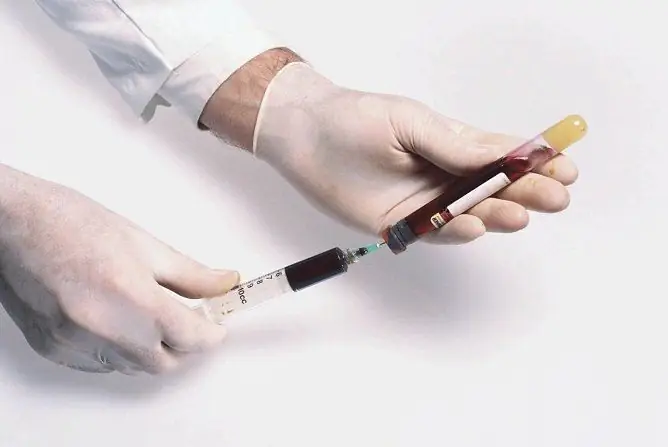- Author Rachel Wainwright [email protected].
- Public 2023-12-15 07:39.
- Last modified 2025-11-02 20:14.
Tests for hepatitis C: indications, types, decoding
The content of the article:
- Indications for referral for tests for hepatitis C
- Types of tests for hepatitis C
- Preparation for the test
- Decoding the results
- What does a positive hepatitis C test mean?
- Symptoms that require testing for hepatitis C
- Hepatitis C treatment
Hepatitis C is damage to liver tissue due to an inflammatory process caused by an RNA virus. This type of virus was first identified in 1988.
The disease can proceed in an acute or chronic form, but more often it is characterized by a long latent, i.e., asymptomatic course. The tendency to chronic disease is due to the ability of the pathogen to mutate. Due to the formation of mutant strains, the HCV virus escapes the immune supervision and remains in the body for a long time without causing pronounced symptoms of the disease.
The prolonged inflammatory process caused by HCV causes destruction of liver tissue. The process is hidden due to the compensatory capabilities of the liver. Gradually, they are depleted, and signs of hepatic dysfunction appear, usually this indicates its deep damage. The task of the analysis for hepatitis C is to identify the disease at a latent stage and begin treatment as early as possible.

Several tests are used to diagnose hepatitis C by taking blood from a vein.
Indications for referral for tests for hepatitis C
Tests for hepatitis C are carried out for the following reasons:
- examination of persons who have had contact with infected;
- diagnosis of hepatitis of mixed etiology;
- monitoring the effectiveness of the treatment;
- cirrhosis of the liver;
- preventive medical examination of healthcare workers, employees of preschool institutions, etc.
The patient can be referred for analysis if there are signs of liver damage:
- enlarged liver, pain in the right hypochondrium;
- yellowness of the skin and whites of the eyes, itching;
- enlargement of the spleen, vascular "spiders".
Types of tests for hepatitis C
To diagnose hepatitis C, both the direct isolation of the virus in the blood and the identification of indirect signs of its presence in the body - the so-called markers - are used. In addition, the functions of the liver and spleen are examined.
Markers of hepatitis C - total antibodies to HCV virus (Ig M + IgG). The first (in the fourth to sixth week of infection) IgM antibodies begin to form. After 1.5-2 months, the production of IgG antibodies begins, their concentration reaches a maximum from 3 to 6 months of the disease. This type of antibody can be found in serum for years. Therefore, the detection of total antibodies makes it possible to diagnose hepatitis C starting from the 3rd week after infection.
Antibodies to HCV are determined by enzyme-linked immunosorbent assay (ELISA), an ultrasensitive test that is often used as a rapid diagnostic test.
To determine the RNA of the virus in the blood serum, the polymerase chain reaction (PCR) method is used. This is the main test for diagnosing hepatitis C. PCR is a qualitative test that detects only the presence of the virus in the blood, but not its quantity.
Determination of the level of antibodies HCVcor IgG NS3-NS5 is necessary to exclude or confirm the diagnosis in the presence of a negative PCR result.
To diagnose liver function, liver tests are prescribed - determination of ALT (alanine aminotransferase), AST (aspartate aminotransferase), bilirubin, alkaline phosphatase, GGT (gamma-glutamyl transferase), thymol test. Their indicators are compared with tables of norms; a comprehensive assessment of the results is important.
An obligatory stage of diagnosis is a blood test with the determination of the leukocyte formula and platelets. With hepatitis C, a general blood test reveals a normal or reduced number of leukocytes, lymphocytosis, a decrease in ESR, and a biochemical blood test - hyperbilirubinemia due to the direct fraction, an increase in ALT activity, and protein metabolism disorders. In the initial period of hepatitis, the activity of some substances that are normally contained in hepatocytes and enter the blood in very small quantities also increases - sorbitol dehydrogenase, ornithinecarbamoyltransferase, fructose-1-phosphataldolase.
A general urine analysis with sediment microscopy will reveal urobilin in the urine, and bilirubin in the later stages of the disease.
A hardware study of the abdominal organs, including the liver, is carried out - ultrasound, computed or magneto-nuclear tomography.
An important method for diagnosing hepatitis C is morphological examination of a liver biopsy. It not only supplements the data of biochemical, immunological and apparatus studies, but also often indicates the nature and stage of the pathological process, which other methods do not detect. Morphological examination is necessary to determine the indications for interferon therapy and to assess its effectiveness. Liver biopsy is indicated for all patients with hepatitis C and HBsAg carriers.
Preparation for the test
To test for hepatitis C, you need to donate blood from a vein. How to properly prepare for blood sampling? Can I eat and drink before the test?
The analysis is taken strictly on an empty stomach. At least 8 hours should elapse between the last meal and blood draw. Before taking the test, you need to exclude physical activity, smoking, alcohol, fatty and fried foods, carbonated drinks. You can drink clean water. Most laboratories take blood for analysis only in the first half of the day, so they donate blood in the morning.
Decoding the results
Analyzes for the determination of antibodies to the hepatitis virus are qualitative, that is, they indicate the presence or absence of antibodies, but do not determine their quantity.
If anti-HCV antibodies are detected in the serum, a second analysis is prescribed to exclude a false positive result. A positive response on re-analysis indicates the presence of hepatitis C, but does not differentiate between acute and chronic forms.
In the absence of antibodies to the virus, the response is "negative". However, the absence of antibodies cannot rule out infection. The answer will also be negative if less than four weeks have passed since the infection.
Could the analysis result be wrong? Inadequate preparation for analysis can lead to false results. A false positive result can be obtained in the following cases:
- contamination of the presented biomaterial;
- the presence of heparin in the blood;
- presence of proteinaceous, chemical substances in the sample.
What does a positive hepatitis C test mean?
Hepatitis C is transmitted from person to person, usually by the parenteral route. The main route of transmission is through contaminated blood, as well as through other biological fluids (saliva, urine, semen). The blood of carriers of the infection is dangerous before they show symptoms of the disease and retains the ability to become infected for a long time.
There are over 180 million people in the world infected with HCV. There is currently no vaccine for hepatitis C, but research is underway to develop one. Most often, the pathogen virus is detected in young people aged 20-29 years. The viral hepatitis C epidemic is growing, and about 3-4 million people are infected every year. The number of deaths from complications of the disease is more than 390 thousand per year.
In some population groups, infection rates are much higher. So, at risk are:
- often hospitalized patients;
- patients requiring continuous hemodialysis;
- blood recipients;
- patients of oncologic dispensaries;
- organ transplant recipients;
- professional groups of medical workers in direct contact with the blood of patients;
- children born to infected mothers (with high concentrations of the virus in the mother);
- carriers of HIV;
- sexual partners of people with hepatitis C;
- people in custody;
- people who inject drugs, patients of drug dispensaries.
The transmission of the virus occurs through close contact with a virus carrier or the ingestion of infected blood into the body. The sexual and vertical route of infection (from mother to child) is recorded in rare cases. In 40-50% of patients, it is not possible to find the exact source of infection. The hepatitis C virus is not spread by shaking hands, kissing and most household items, such as shared utensils. But if there is an infected person in the family, care must be taken: manicure supplies, a razor, a toothbrush, and washcloths cannot be shared, as traces of blood may remain on them.

Analysis for hepatitis C is carried out during medical examinations and when suspicious symptoms appear
At the time of infection, the virus enters the bloodstream and settles in those organs and tissues where it multiplies. These are liver cells and blood mononuclear cells. In these cells, the pathogen not only multiplies, but also remains for a long time.
Then HCV damages liver cells (hepatocytes). The causative agent penetrates into the liver parenchyma, changing its structure and disrupting vital functions. The process of destruction of hepatocytes is accompanied by the proliferation of connective tissue and its replacement of liver cells (cirrhosis). The immune system produces antibodies to liver cells, increasing their damage. Gradually, the liver loses its ability to perform its functions, and serious complications develop (cirrhosis, liver failure, hepatocellular carcinoma).
HCV antigens have a low ability to induce immune responses, so early antibodies to them appear only 4-8 weeks after the onset of the disease, sometimes even later, antibody titers are low - this complicates early diagnosis of the disease.
Symptoms that require testing for hepatitis C
The intensity of the symptoms of the disease largely depends on the concentration of the virus in the blood, the state of the immune system. The incubation period is on average 3-7 weeks. Sometimes this period lasts up to 20-26 weeks. The acute form of the disease is rarely diagnosed and more often by accident. In 70% of cases of acute infection, the disease goes away without clinical manifestations.
Symptoms that may indicate acute hepatitis C:
- general malaise, weakness, decreased performance, apathy;
- headache, dizziness;
- decreased appetite, decreased tolerance to food loads;
- nausea, dyspepsia;
- heaviness and discomfort in the right hypochondrium;
- fever, chills;
- itchy skin;
- darkening, frothy urine (urine that looks like beer);
- joints and heart muscle damage;
- enlargement of the liver and spleen.
Icteric coloration of the skin may be absent or appear for a short time. In about 80% of cases, the disease is anicteric. With the onset of jaundice, the enzymatic activity of hepatic transaminases decreases.
Usually, the symptoms are erased, and patients do not attach much importance to clinical manifestations, therefore, in more than 50% of cases, acute hepatitis turns into chronic. In rare cases, an acute infection can be severe. A special clinical form of the disease - fulminant hepatitis - is accompanied by severe autoimmune reactions.
Hepatitis C treatment
Treatment is carried out by a hepatologist or infectious disease specialist. Antiviral drugs, immunostimulants are prescribed. The duration of the course, the dosage and the regimen of administration depend on the form of the course and the severity of the disease, but on average the duration of the course of antiviral therapy is 12 months.
YouTube video related to the article:

Anna Kozlova Medical journalist About the author
Education: Rostov State Medical University, specialty "General Medicine".
Found a mistake in the text? Select it and press Ctrl + Enter.






